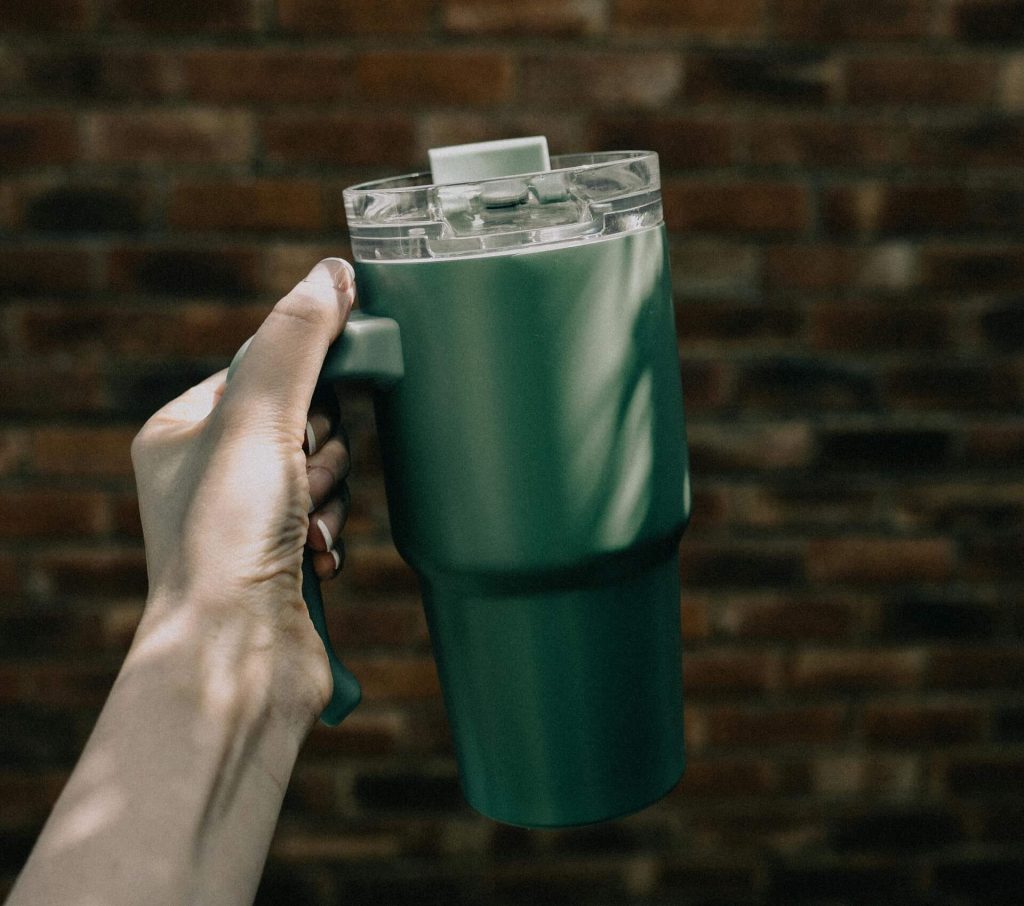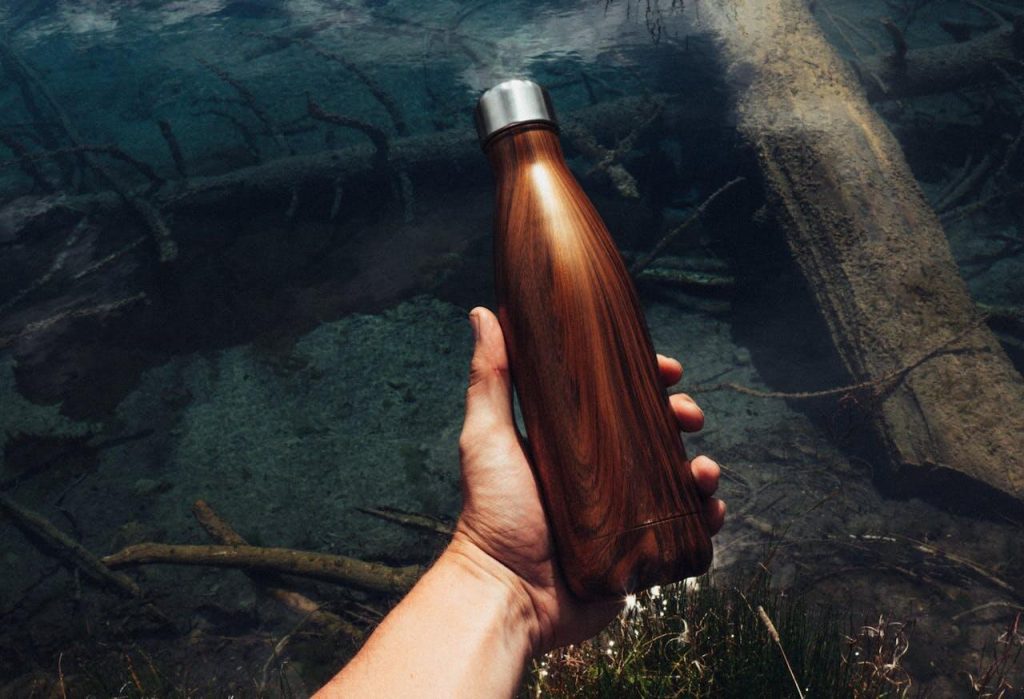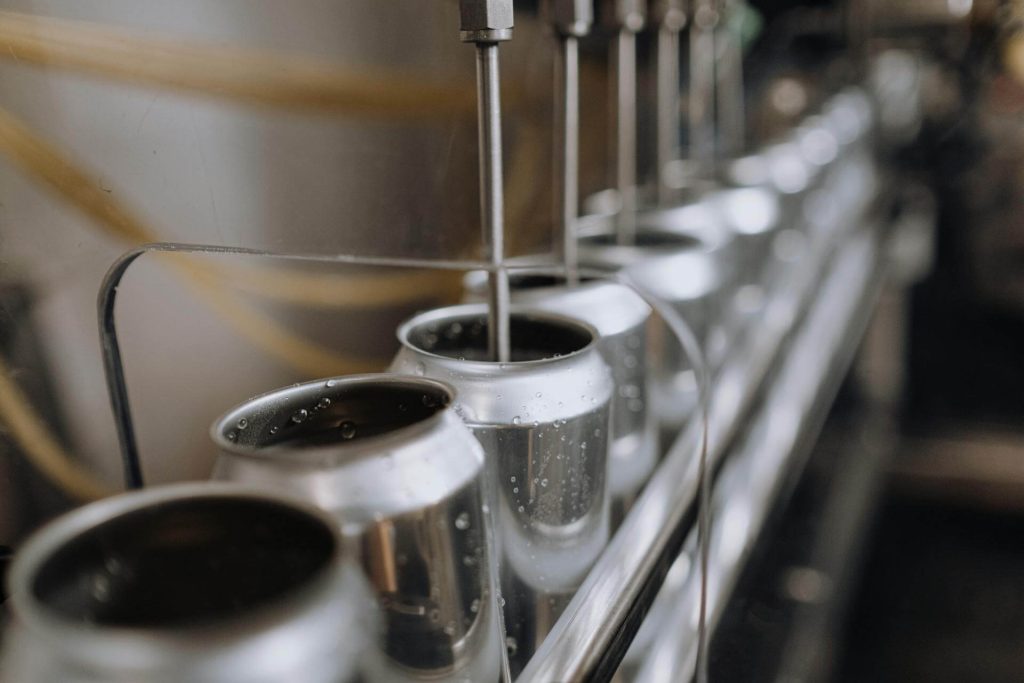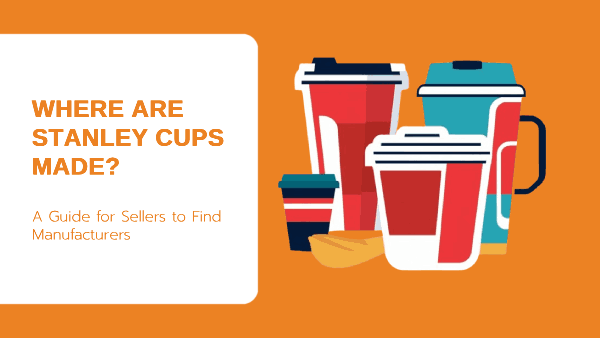Stanley Cups have become iconic in the world of drinkware, especially with their rise in popularity on social media platforms like TikTok and Instagram. As a seller seeking to source drinkware for your business, you might wonder: Where are Stanley Cups manufactured?
To put it simply, Stanley Cups are primarily made in China and Brazil. This global manufacturing approach has helped maintain high standards of quality while keeping production efficient and cost-effective.
In this guide, you’ll find detailed information about the manufacturing origins of Stanley Cups and practical tips for sourcing high-quality tumblers for your business.
What Company Manufactures Stanley Cups?

- Founded in 1913, Stanley was created by William Stanley Jr., who introduced the first all-steel vacuum bottle and set the foundation for durable, insulated drinkware.
- Over the decades, Stanley expanded its product range beyond vacuum bottles to include tumblers, mugs, flasks, and lunch containers, becoming a well-known outdoor and lifestyle brand.
- In 1965, the Stanley brand was acquired by Aladdin Industries, during which some manufacturing operations were based in the United States, including Tennessee.
- Today, Stanley is owned by PMI Worldwide (Pacific Market International). PMI operates Stanley as a brand and product company, not a factory.
- Stanley cups are not manufactured in-house. Production is outsourced to specialized drinkware manufacturers, primarily located in China, where stainless steel and vacuum-insulated drinkware manufacturing is highly developed.
- The brand’s recent global popularity is largely driven by the Stanley Quencher tumbler, which went viral on social media. Between 2019 and 2023, Stanley’s reported annual revenue grew from approximately $70 million to over $750 million.
PMI continues to oversee design, quality standards, and sustainability initiatives, including a commitment to increase the use of recycled stainless steel across its product lines.
Where Are Stanley Cups Made?

Stanley Cups have a rich history, with manufacturing locations that have evolved over the years. Here’s a look at where these iconic cups are made today:
China
Since 2002, Pacific Market International (PMI) has owned Stanley. Most Stanley products are now made in China. This location helps maintain quality while keeping costs competitive.
The China facilities can handle large-scale production. This helps meet the rising global demand for Stanley products. PMI Worldwide, Stanley’s parent company, owns one factory in China.
The exact location of this factory is not specified. However, PMI has offices in Shanghai and Shenzhen. These cities are known for manufacturing. So, the factory might be near one of these areas.
Other Manufacturing Regions
Stanley products are also made in Brazil. They own two manufacturing facilities there.
PMI ensures that suppliers in Brazil maintain strict quality and ethical standards. This helps spread out production and reduces the risk of relying on one location.
Stanley’s commitment to high quality and ethical standards is central to their manufacturing process.
While production has shifted internationally, Stanley remains committed to delivering high-quality, long-lasting drinkware. Every facility is carefully monitored to ensure that every product lives up to the brand’s reputation.
How Are Stanley Cups Made?
The manufacturing process of Stanley Cups is meticulous and combines traditional craftsmanship with modern techniques. Here’s a step-by-step breakdown:
- Material Selection: Made from high-quality stainless steel, known for its strength and insulation properties.
- Cutting and Shaping: Steel sheets are cut and formed into the iconic cup shape using precision machinery.
- Assembly: Multiple layers are assembled to create a vacuum-sealed structure, keeping drinks hot or cold for hours.
- Polishing and Coating: The cups are polished for a smooth finish, with some models receiving a powder-coated exterior for added durability and color variety.
- Engraving: Logos, measurements, and other markings are engraved on the cup using precise laser technology.
- Inspection: Each cup undergoes rigorous testing to ensure it meets Stanley’s durability and performance standards.
- Packaging: Finally, the cups are packaged in sustainable materials, reflecting Stanley’s commitment to environmental responsibility.
This process ensures that every Stanley Cup is built to last, combining cutting-edge technology with time-tested quality.
Key Materials Used by Stanley Cup Manufacturers
The performance and durability of Stanley cups are driven primarily by material selection, not branding. Manufacturers that produce Stanley-quality tumblers rely on a small set of proven materials that support insulation, safety, and long-term use.
Food-Grade Stainless Steel (304)
Stanley cups are made using 304 stainless steel for both the inner and outer walls. This grade is widely used in premium drinkware because it is:
- Corrosion-resistant
- Non-reactive with beverages
- Durable under repeated temperature changes
- Safe for food and beverage contact
For private-label buyers, confirming true 304 stainless steel (not 201 or mixed grades) is essential for product longevity and performance.
Double-Wall Vacuum Insulation
Stanley cups use double-wall vacuum insulation, where air is removed from the space between two stainless steel walls. This structure:
- Keeps beverages hot or cold for extended periods
- Reduces external condensation
- Improves overall temperature stability
The quality of the vacuum seal and welding process has a direct impact on insulation performance and unit consistency.
Powder-Coated Exterior Finish
Most Stanley tumblers feature a powder-coated exterior, which provides:
- Improved grip
- Scratch and chip resistance
- Long-lasting color durability
Higher-quality powder coatings add cost but significantly improve product lifespan and customer satisfaction.
BPA-Free Plastic Components (Lids and Straws)
Lids and straws are typically made from BPA-free plastic, designed to be safe, durable, and compatible with hot and cold liquids. Material quality affects:
- Leak resistance
- Heat tolerance
- Fit and sealing performance
Poor-quality plastic components are one of the most common failure points in low-cost tumbler production.
Recycled Stainless Steel (Sustainability Focus)
Stanley’s parent company, Pacific Market International (PMI), has publicly committed to increasing the use of recycled stainless steel across its product lines. This supports sustainability goals while maintaining performance standards.
For brands targeting eco-conscious consumers, working with manufacturers that can source certified recycled steel is becoming an increasingly important consideration.
The Top Stanley Cups Suppliers in China

If you’re looking for high-quality stainless steel tumblers, China is home to some of the best manufacturers.
Many factories specialize in vacuum-insulated drinkware, offering private labeling, bulk production, and competitive pricing.
Here are some of the leading suppliers:
1. Wuyi Husen Outdoor Products Co., Ltd.
- Location: Wuyi, Zhejiang
- Specialization: Double-walled vacuum tumblers with custom branding and OEM manufacturing services.
- Strengths: Advanced production capabilities and strict quality control measures to maintain consistency.
2. Yongkang Shiqiang Hardware Plastic Co., Ltd.
- Location: Yongkang, Zhejiang
- Specialization: Vacuum-insulated bottles, travel mugs, and promotional drinkware.
- Strengths: In-house tooling and injection molding capabilities enable fast and cost-effective OEM/ODM project development.
3. Jinhua Yihui Metal Products Co., Ltd.
- Location: Jinhua, Zhejiang
- Specialization: Stainless steel flasks, mugs, and tumblers with custom engraving and logo printing services.
- Strengths: Offers tailored branding solutions and a variety of finishes to match different market needs.
4. Hangzhou Uhome Houseware Co., Ltd.
- Location: Hangzhou, Zhejiang
- Specialization: Eco-friendly tumblers made from BPA-free materials with ODM services for unique product designs.
- Strengths: Prioritizes sustainable manufacturing practices while maintaining high product durability and aesthetics.
5. Yongkang Kete Household Co., Ltd.
- Location: Yongkang, Zhejiang
- Specialization: Custom travel mugs and vacuum-insulated tumblers with an emphasis on durability and heat retention.
- Strengths: Strong presence in international markets and the capacity to fulfill large-scale wholesale orders efficiently.
How Much Does It Cost to Manufacture a Stanley-Style Cup?
Although Stanley tumblers retail for $45–$55, the actual manufacturing cost of a Stanley-style 40 oz stainless steel tumbler is significantly lower.
For buyers sourcing from China, the typical EXW (Ex-Works) manufacturing cost ranges from $3.50 to $6.50 per unit.
The final cost depends on several production variables rather than branding.
Key Cost Factors in Manufacturing
- Stainless steel grade: Most Stanley-style tumblers use food-grade 304 stainless steel for both inner and outer walls. Higher steel thickness and tighter tolerances increase cost.
- Vacuum insulation quality: Double-wall vacuum sealing is one of the most important cost drivers. Better insulation performance requires more precise welding, evacuation, and quality control.
- Surface finish and coating: Powder coating, matte textures, scratch-resistant finishes, or specialty colors increase unit cost compared to basic polished steel.
- Lid and straw components: Injection-molded lids, leak resistance, and BPA-free materials can affect tooling and per-unit pricing.
- Customization and packaging: Laser logos, custom molds, color matching, and retail-ready packaging typically add to the base cost, especially at lower order volumes.
Why the Retail Price Is Much Higher
The gap between manufacturing cost and retail price reflects branding and distribution economics, not production alone. Brands like Stanley—owned by Pacific Market International (PMI), price in additional costs such as:
- Marketing and influencer campaigns
- Global logistics and warehousing
- Distributor and retailer margins
- Product compliance, certifications, and liability
- Inventory risk and unsold stock
This is why a tumbler that costs under $7 to manufacture can retail for over $45.
What This Means for Buyers
For private-label and OEM buyers, understanding these costs is critical. The difference between a cheap knock-off and a premium Stanley-quality alternative is usually not price alone, but factory capability, material standards, and quality control.
Buyers who focus only on the lowest quote often compromise on insulation performance, coating durability, or long-term consistency.
Buyers who understand the real cost structure can allocate budget more strategically and build products that compete on quality rather than price.
How to Find Manufacturers for Stanley-Style Tumblers

When looking for reliable manufacturers for products similar to Stanley Cups, you need to consider several factors, such as customization, insulation technology, and the manufacturer’s reputation.
1. Search on Verified B2B Platforms
Websites like Alibaba, GlobalSources, and Made-in-China list thousands of suppliers specializing in stainless steel vacuum tumblers. When searching, use keywords like:
- Vacuum-insulated tumbler manufacturer
- Custom stainless steel travel mug
- OEM thermal flask factory
Pro Tip: Look for suppliers with Gold Supplier status on Alibaba, high transaction levels, and positive customer reviews.
2. Focus on Customization & Branding
For private-label tumblers, look for a manufacturer that provides:
- Custom logos and engravings (laser engraving, silk screen printing)
- Color variations and finishes (powder coating, gradient effects)
- Unique lid and handle designs
Advantages of Sourcing from China
Sourcing from China is popular due to cost-effectiveness and manufacturing capabilities.
Manufacturers here offer competitive pricing, extensive production capabilities, and quality products.
This guide to sourcing products from China can help you get started.
Sourcing Agents
Consider using Sourcing Agents. They can help you navigate the complexities of finding and dealing with manufacturers in China.
Finding the right manufacturer is crucial. For more tips, you can read this complete guide on getting products manufactured.
It explains the steps clearly and can help you navigate the sourcing process effectively.
Key Factors to Consider When Choosing a Manufacturer
When choosing a manufacturer, most people only think about pricing and shipping times.
But there are many other factors to consider that vary from product to product.
For Stanley-style tumblers, here are some things to keep in mind. :
- Production Capabilities – Evaluate if the manufacturer can meet your demand for Stanley Cups. Check their equipment, workforce, and ability to scale production. Make sure they have the capacity to handle your orders.
- Quality Control – Look for ISO certifications, third-party audits, and strict inspection processes to guarantee consistent product quality.
- Lead Time – Shorter production times are ideal, but ensure speed doesn’t compromise quality. Verify estimated timelines before committing.
- Industry Experience – Prioritize manufacturers with a track record in stainless steel drinkware production, as they understand market requirements and durability standards.
- Intellectual Property Protection – Make sure your designs are safe. Learn how toprotect your product from being copied by unauthorized manufacturers.
- Quality Inspection – Regular quality inspections help maintain your product standards. Make sure the manufacturer allows and cooperates with these checks.
Frequently Asked Questions
Who Invented Stanley Cups?
Stanley Cups were invented by William Stanley Jr. in 1913. He revolutionized drinkware by introducing vacuum insulation technology, which helped keep beverages hot or cold for extended periods.
Why Are Stanley Cups Suddenly So Popular?
Stanley Cups have surged in popularity due to viral social media trends, influencer endorsements, and their stylish yet functional design.
Their large capacity, durability, and ability to keep drinks cold for hours make them a favorite among consumers, especially in the hydration and lifestyle market.
What Tumblers and Thermos Are Made in America?
While many popular brands of tumblers and thermoses, such as Stanley, YETI, Hydro Flask, and Thermos, are designed in the United States, their manufacturing is primarily done overseas, particularly in China. However, there are a few brands that produce their tumblers and thermoses in the USA. Here are some notable examples:
- Liberty Bottleworks
- ThermoServ
- Tervis
- Polar Bottle
- Anchor Hocking
How Does the Location of Manufacturing Affect the Quality of Stanley Cups?
Manufacturing location impacts cost, quality, and production time. For example, cups made in China might be cheaper due to lower labor costs. However, always check the manufacturer’s quality control standards.
What Are the Most Popular Materials Used in the Making of Stanley Cups?
Stanley cups are commonly made from stainless steel. Stainless steel is durable and resistant to rust. Some models might use high-quality plastic for certain parts, ensuring they are lightweight yet sturdy. Insulated versions often have a vacuum seal to maintain temperature.
Finding a Drinkware Manufacturer with Niche

Sourcing high-quality insulated tumblers requires more than just finding a supplier. It’s about choosing a manufacturer that aligns with your brand’s quality expectations, production needs, and customization goals.
Whether you prioritize scalability, cost-efficiency, or sustainable materials, the right manufacturing partner can make a significant difference in your product’s success.
When sourcing insulated water Bottles from China, consider reaching out to professionals who can help you find reliable manufacturers.
A company like NicheSources can assist you in connecting with reliable suppliers. We can help ensure your products meet high standards and are produced at a reasonable cost.
If you’re ready to start sourcing, you can request a free quote from Quick Quote to get started. This can be a great way to find the right partner for your drinkware needs.

